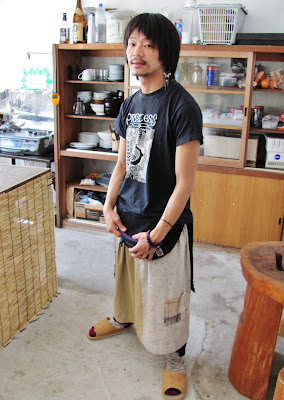Age: 32. Occupation: proud owner of the Ise Kazami Guesthouse, probably the one and only hostel in Ise-shi, Mie.
Earlier last weekend my friends and I traveled to Ise and stayed at
Kazami Guesthouse, located close to the station on a quiet street
(Fukiage) which is dotted with various small boutiques and thrift shops. We were greeted personally by Marui-san (who likes to go by Hiro, so I will go with Hiro-san for this blog) the moment we stepped through the doors.
As soon as we entered I was immediately struck by Hiro-san's blend of ethnic-alternative fashion taste. I was equally taken by the friendly and earthy atmosphere of the hostel. I decided to ask if it was ok for me to interview him for the blog and take a few pictures,which he was more than happy to help with.
It turns out that the hostel had just been purchased, renovated, and opened by Hiro-san only five months ago. Before that the building was the site of an old, rundown ryokan that was suffering from various water damage and sewer problems. When I asked Hiro-san what made him want to buy and start a hostel business, he said that he simply wanted to create a warm, cafe-like environment where travelers to Ise from all over could gather and share their experiences together. Being a local native from Ise himself, he thought that transforming the old ryokan eyesore into a new, livelier place was a good way to help improve the image of the neighborhood. Hiro-san said that he hopes he will be able to make many friends from all around the world at the hostel, because one of his life goals is to travel to many different countries one day.
The instruments in the corner of the lounge (drum, guitar, and sanshin) reflect Hiro-san's own musical background as he used to be in a punk-rock band. Before that, Hiro-san worked as an AC technician (a job he thought he was very bad at!)
Together with some artist friends who helped paint the many interesting and beautiful murals that decorate the inside of hostel, Hiro-kun was able to fix up and open Kazami. Also there that day was one of his friends, a recent Princeton graduate from India who drops by and helps volunteer at the hostel when he's not busy with his job at the municipal government office. In the meantime, small repairs like fixing the column and sweeping the floors in the morning are still dutifully done by Hiro-san personally.
 |
| Making friends on facebook |
In the evenings, Hiro-san loves to socialize with his guests with a round of drinks in the lounge, or just take everyone out for a midnight hike up the mountains from some stargazing (we were all too tired, so had to decline). When I asked how he spoke English so well, Hiro-san admitted that he learned it entirely through playing Nintendo games. For now, English is the only foreign language Hiro-san knows although Hiro-san says he would love to learn others.
 |
| Proud owner and business |
 |
| Was offered to stay and work as a staff! |
I loved being able to speak with Hiro-san, and loved how he was able to incorporate his globe-treading dreams into his hostel. I will be sure to visit again whenever I return to Ise!















